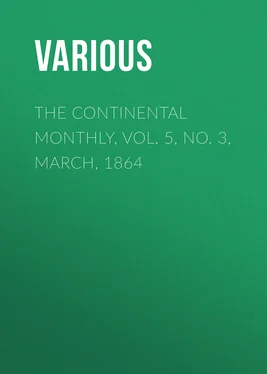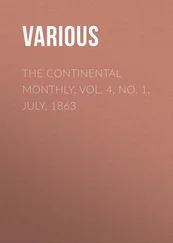Various - The Continental Monthly, Vol. 5, No. 3, March, 1864
Здесь есть возможность читать онлайн «Various - The Continental Monthly, Vol. 5, No. 3, March, 1864» — ознакомительный отрывок электронной книги совершенно бесплатно, а после прочтения отрывка купить полную версию. В некоторых случаях можно слушать аудио, скачать через торрент в формате fb2 и присутствует краткое содержание. Жанр: foreign_antique, periodic, Языкознание, Политика, foreign_edu, на английском языке. Описание произведения, (предисловие) а так же отзывы посетителей доступны на портале библиотеки ЛибКат.
- Название:The Continental Monthly, Vol. 5, No. 3, March, 1864
- Автор:
- Жанр:
- Год:неизвестен
- ISBN:нет данных
- Рейтинг книги:3 / 5. Голосов: 1
-
Избранное:Добавить в избранное
- Отзывы:
-
Ваша оценка:
- 60
- 1
- 2
- 3
- 4
- 5
The Continental Monthly, Vol. 5, No. 3, March, 1864: краткое содержание, описание и аннотация
Предлагаем к чтению аннотацию, описание, краткое содержание или предисловие (зависит от того, что написал сам автор книги «The Continental Monthly, Vol. 5, No. 3, March, 1864»). Если вы не нашли необходимую информацию о книге — напишите в комментариях, мы постараемся отыскать её.
The Continental Monthly, Vol. 5, No. 3, March, 1864 — читать онлайн ознакомительный отрывок
Ниже представлен текст книги, разбитый по страницам. Система сохранения места последней прочитанной страницы, позволяет с удобством читать онлайн бесплатно книгу «The Continental Monthly, Vol. 5, No. 3, March, 1864», без необходимости каждый раз заново искать на чём Вы остановились. Поставьте закладку, и сможете в любой момент перейти на страницу, на которой закончили чтение.
Интервал:
Закладка:
Romance and poetry have not often been successful in treating of the character and customs of our aborigines, for the elements of true heroism in the savage nature are so exceptional and few, that the red man is a very poor subject for the higher manifestations of art. Cooper and Longfellow alone have come back from this field with the trophies of praise. But Palmer, with a striking originality and a subtle perception of spiritual influences, sees in the effect of Christianity on the 'untutored mind' of the Indian, a theme to inspire his plastic clay. So from this idea he evolves the 'Indian Girl,' standing in an attitude of perfect repose, holding in her right hand a crucifix, on which her eyes are bent pensively in a sweet, absorbing reverie, which shuts out the consciousness of the external world. In the other hand, which hangs listlessly by her side, she barely touches rather than holds a bunch of feathers, evidently gathered to adorn her person, and which she forgets in the contemplation of the story of the Cross. The artist supposes she has found this crucifix, which the early Catholic missionaries were wont to attach to the forest trees, and having heard from some of these zealous teachers an exposition of Christ's mission, the better life has already begun to dawn in her soul, and her whole aspect tells that this mysterious influence is upon her.
The features are Indian, fair and comely—we do not say beautiful, because this term expresses the highest excellence, and ought as a descriptive phrase to be more sparingly used. The face is idealized, as the rules of true art always require, but still preserves its fidelity to the natural type. The form is nude to the waist, the drapery arranged with unrivalled grace, the hair is clubbed so as to reveal the neck and shoulders, while the perfection of contour and the completeness of development satisfy the most critical eye for the study of detail. The 'Indian Girl' forms one of the landmarks in the history of American sculpture.
But Palmer's grand, characteristic work, in which his genius seems to have reached its noblest expression, is the 'White Captive,' which we believe to be one of the most perfect creations of ancient or modern art. It is something more than the nude figure of a surpassingly beautiful woman, bound to the stake, and defying the gaze of her barbarous captors—it is not merely an exciting incident in pioneer life, but it has a grand symbolical meaning that reaches beyond a literal interpretation of the situation.
We see in this statue the contact of civilization with savage instinct, and in the expression of the 'White Captive,' peering through maiden timidity, and rising triumphant above physical fear in a look of intellectual and religious strength, before which the swarthy warrior feels himself in the presence of a superior power—a ruler! As we gaze on in mute admiration, we behold the race of the red man receding westward before that same power pictured in this wonderful face: now the Indian tribes pass the Rocky mountains, they come within the roar of the Pacific, and, growing less and less, they at last vanish away into the uncertain mists of the ocean—a lost people, who have served the purpose for which they were created, and disappeared from our continent to make room for a nobler humanity. It is this melancholy fate, this glorious triumph, that Palmer has recorded in a language more forcible than history, more eloquent than song, more ravishing than the lyre! To define how the statue spreads before you this great vision, eludes the acutest analysis; but there it is, told just as plainly as the Falls of Niagara or the eternal stars tell the omnipotence of God.
The longer one studies this marvellous work, the more he sees to admire, to reflect upon. There is something in the general effect that makes the beholder forget the perfect nudity of the figure, which necessarily grows out of the circumstances of the case, and which is entirely unfelt by the captive in her terrible realization of the peril which surrounds her. Thus two great difficulties that embarrass the execution of undraped statuary are entirely overcome:
1. The nudity is only incidental to the general effect, and the subject seems entirely unconscious of the fact.
2. The nudity is accounted for by the situation—the captive is tied unclad to a tree, to be burned alive, according to Indian custom.
Thus a criticism that has been frequently made (and not unjustly) on the morale of certain works of art, has no application to this.
Of the details of this ideal creation—its matchless finish, the graceful undulations of the perfect form, the firmness expressed in the clenched fingers, the instinctive shudder gathered on the fair brow, the lofty defiance of the eyes and half-parted lips, the radiant beauty of the face—we can only say they live in our memory, but too deep for words. We believe the truth of the artist's conception, that the revengeful savages acknowledged the divinity of her beauty and Christian reliance, and the 'White Captive' went free—the spirit of civilization triumphed!
As a man's character is always more or less associated with his achievements, the reader may wish to learn something of Mr. Palmer as a man. In all kinds of soul-work, there is ever perceptible a certain flavor of the mind which produces it, and the things thus created usually suggest the qualities of the creator. So the works of the sculptor are to some degree the exponents of his character, the expressions of his inner life.
Therefore in Mr. Palmer we should expect moral and intellectual worth of a high order, added to the purest and most exalted motives. He is in spirit a reformer, taking an interest in every measure for the improvement of our race, and sympathizing with every struggle of our aspiring manhood.
The eccentricities, excuses, and conventional affectations of many real and pretended geniuses he entirely eschews, feeling himself one of the people, and laboring for their elevation.
Neither does he deem it any part of genius to neglect his family, forget to pay his butcher's bill, and ignore the claim of his tailor. His ample house and neat atelier, at the north end of Eagle street, in the city of Albany, are the fruit of his patient and inspiring toil—his chisel has won him moderate fortune as well as world-wide fame.
Photographs of the 'Palmer Marbles' are seen in the show windows of Paris, London, and Berlin, while in this country they help to fill the portfolios of the virtuoso , adorning the walls of the parlor and the private gallery.
Though in youth Palmer did not receive an average common-school education, he converses like a man of liberal culture, showing that he belongs to the class of self-made men.
He has never visited the interminable art palaces of Europe, nor studied, in the sense in which that term is used, the 'old masters;' still he has appropriated all the valuable hints to be obtained from the classic models, without regarding them as the ne plus ultra of artistic execution, and therefore to be only imitated, to the exclusion of the higher ideals of an advanced civilization.
He has an intelligible and correct theory in regard to the fidelity of art to nature. For instance, he insists that he should represent , not imitate; and in making a bust of a man, the sculptor should express the higher moods of his subject, and show him with his better qualities brought to the surface. So the forms of nature should be idealized in the direction of their primitive tendency, and thus art help to express that ineffable longing of the soul, that reaching upward for a perfection that is approximated on earth, but never attained. This idealization is like the humor of Dickens, something more than nature in its grotesqueness, yet a stimulated growth of the natural quality. Palmer always takes nature for his model, and then assimilates it to that ideal beauty which dwells in his imagination and sheds a spiritual halo over the creation of his chisel.
Читать дальшеИнтервал:
Закладка:
Похожие книги на «The Continental Monthly, Vol. 5, No. 3, March, 1864»
Представляем Вашему вниманию похожие книги на «The Continental Monthly, Vol. 5, No. 3, March, 1864» списком для выбора. Мы отобрали схожую по названию и смыслу литературу в надежде предоставить читателям больше вариантов отыскать новые, интересные, ещё непрочитанные произведения.
Обсуждение, отзывы о книге «The Continental Monthly, Vol. 5, No. 3, March, 1864» и просто собственные мнения читателей. Оставьте ваши комментарии, напишите, что Вы думаете о произведении, его смысле или главных героях. Укажите что конкретно понравилось, а что нет, и почему Вы так считаете.












